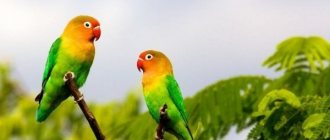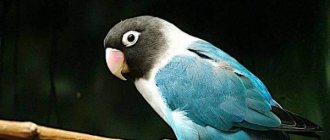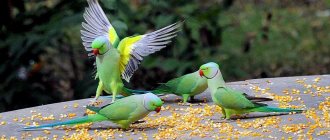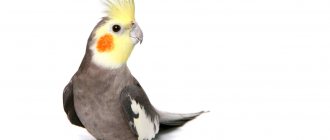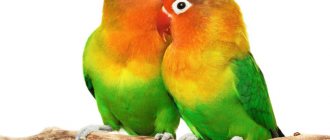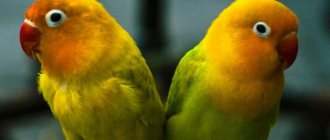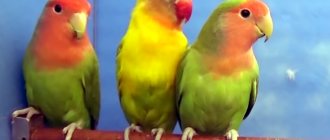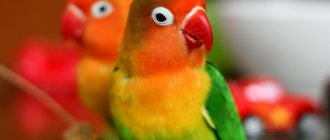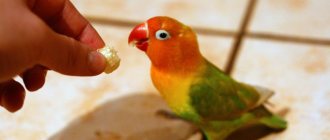Rosy-cheeked lovebirds are small parrots with original colors and a playful, sociable disposition. Due to their ease of care and ability to speak, these charismatic, colorful birds are popular among bird lovers, but sometimes they present unpleasant surprises. Let's look at the main features of rosy-cheeked lovebirds and the specifics of their maintenance.
Description of rosy-cheeked lovebirds
The body length of an adult is 16-17 centimeters, the wing length reaches 10 centimeters. Body weight varies between 48-60 grams. The pink-headed lovebird has a stocky body. The beak is light yellow. The iris of the eyes is dark brown. Legs are grey-green. The tail is short, slightly pointed, its length is 4.5-5.5 centimeters.
The main color of the plumage of the rosy-cheeked lovebird is grass-green. At the same time, the upper back, back of the head and crown are bright green, and the belly and chest are light green. The rump and loin are bright blue. The forehead and crown are red, the throat and cheeks are pink.
Lifestyle of rosy-cheeked lovebirds
Pink-headed lovebirds live in small flocks of 5 to 20 individuals. When the time comes to gain weight, parrots gather in numerous flocks - up to 100 individuals.
Rosy-cheeked lovebirds are active during the day, and they spend the night in empty weaver nests. They lead a sedentary lifestyle. They can climb well on vertical surfaces, using their claws and beak, and making active movements with their wings. The flight speed reaches 58 kilometers per hour.
Rose-cheeked lovebird (Agapornis roseicollis).
All members of the pack communicate with each other regularly. When the temperature drops, rosy-cheeked lovebirds gather in groups of 5 individuals and warm each other. They make sounds that are a mixture of chattering and sharp screams.
The diet consists of berries, seeds, fruits, nuts, millet, grains, sunflower seeds, maize and flowers. Food is collected on the ground.
The exact lifespan of pink-headed lovebirds is unknown, but in captivity they can live up to 20 years.
Reproduction of rosy-cheeked lovebirds
The mating season occurs from February to March. During the breeding season, these parrots nest in colonies. They make nests in rocks, under the roofs of houses, tree hollows, or use the nests of weaver birds.
On the ground, pink-cheeked lovebirds move quickly, most often sideways.
Whether parrots occupy abandoned nests or force their owners to abandon them is unknown. The nest is created in the form of a deep bowl, using grass, twigs, bark and leaves. The male does not help the female build the nest, but guards the nest and feeds the female during construction work.
A clutch of pink-headed lovebirds can contain from 4 to 6 white, almost round eggs. Their laying occurs at intervals of 1-2 days. The incubation period lasts 23 days. Full plumage appears in the chicks at 40 days. And at 32-38 days they can already fly out of the nest, but for another 10-14 days their parents feed them. The first molt in young birds occurs at 4-5 months; at 8 months they acquire the color of adult birds. Puberty occurs at 8-12 months.
Young chicks have a brown-black beak with a light tip.
Possible diseases
Improper care of parrots can cause illness: unsanitary conditions, stale food - and the bird picks up an intestinal infection. A draft or non-compliance with the ventilation regime is not far from a cold. Poor, inadequate nutrition - as a result, the lovebird has vitamin deficiency or obesity. Inattention and lack of communication lead to depression and self-plucking.
Non-communicable diseases:
- goiter inflammation (clogging with large food particles);
- diarrhea (caused by sour food);
- hypovitaminosis.
Infectious:
- psittacosis (viral disease);
- salmonellosis.
Parasitic:
- knemidocoptic mange (scabies mites);
- helminthiasis
Signs of some diseases can sometimes not be noticed and can be attributed to the lovebird’s bad mood. The list of avian diseases is wider, these are just the most common. A mild form of illness usually goes away without consequences. If the disease is severe and without veterinary care, the parrot most often dies.
Keeping rosy-cheeked lovebirds in captivity
These are one of the members of the family that are most often kept in captivity. Pink-cheeked lovebirds were first brought to Europe in 1860.
Rosy-cheeked lovebirds live in flocks, and when nesting they split into pairs.
Pink-headed lovebirds are kept in rectangular or square cages. A small cage for a rosy-cheeked lovebird is not suitable - one pair should live in a house measuring 80x30x40 centimeters; when keeping a couple, choose a cage from 100x40x50 centimeters. The bars in the cage should be metal and horizontal. The bottom should slide out. Various materials are placed at the bottom that absorb moisture well.
Bowls for drinking and eating are washed weekly. When dirty, clean the perches and toys. The cage must be disinfected once a week.
In a cage with rosy-cheeked lovebirds, there must be a pond, as these birds love to swim. You can spray lovebird feathers with a spray bottle.
At least 2 perches are hung in the cage at different heights, and ropes, toys, bamboo rings and a sleeping house are also placed.
Features of behavior
Rosy-cheeked lovebirds are most often preferred for keeping at home. And this is not surprising, because they do not require complex care. However, there are also nuances. Birds are often given as a gift, or bought spontaneously, without first studying the characteristics of the species. Therefore, those who already have such a feathered pet are strongly advised to first get acquainted with the list of possible difficulties, and only then buy a bird.
Of the most important features of keeping lovebirds, the first and most important is their very loud cry. Very, very loud! You should pay special attention to this before entering the establishment, because the cries of rosy-cheeked lovebirds are not at all melodious. A loud, shrill and constant squealing is what everyone who plans to keep this parrot at home should be aware of. Therefore, if you have weak nerves, a small child who needs silence to sleep, or poor hearing in the apartment, you should think carefully. Otherwise, later the unfortunate bird will have to be re-gifted and rehomed, but we are responsible for those we have tamed. You can calm down a raging parrot by taking the cage with it into a dark room (a bathroom or bedroom with thick curtains is ideal for this). Some owners advise covering the cage with a blanket, but this is still not worth doing - the bird may suffocate.
The second feature of keeping it is the birds’ free flights around the apartment. A mobile and active bird needs daily flights around the premises, and even a relatively large cage will not be suitable for this purpose. The most ideal conditions for a lovebird are when the cage door is constantly open, and he can fly into it to eat or sleep. Therefore, surprises in the form of “bombs” are inevitable. Repairs in the apartment will also suffer - parrots love to sharpen their beaks on anything they like, tear off wallpaper and even swing on curtains, catching on their sharp claws. The lovebird is mischievous, but at the same time incredibly charming, and you can forgive him for the spoiled interior. The contact bird will become both a companion and an alarm clock, and will make you smile more than once with its cute tricks.
And lastly, you need to remember that the bird has its own character. Lovebird babies are very curious and sociable, so they constantly require attention. Due to frequent overexcitement, they can rush around the room like crazy, knocking over small objects and scattering feathers. If there are other pets in the house, it is possible that the little bullies will tease their competitors, peck and offend them.
Feeding rosy-cheeked lovebirds
The diet of these parrots consists of vegetables, fruits, greens, lettuce, dandelion, grains, millet, carrots, oats, sunflower wheat, canary seed and berries.
Parrots eat fruits, leaves and berries.
Pink-headed lovebirds should not be fed sweet, salty, spicy foods such as cookies, pie chips, chocolate and the like.
Young growing parrots are fed 4-5 times a day, while adults need only be given food once a day. Drinking water is a must and is changed when it gets dirty.
During the breeding season, lovebirds are fed white bread softened in milk or water, a boiled egg, sprouted oats and millet, grated carrots, crumbly wheat porridge, as well as cottage cheese and mealworms.
There should always be a mineral stone in the cage for birds, and young birds are additionally fed with microelements and vitamin C.
Nutrition
The lovebird's diet should not differ from that to which it is accustomed in the wild. It should include fruits, vegetables, cereals, and berries. You can also give him egg shells, which will become a source of calcium. But you should give up sweets. Such desserts can harm your pet. And provoke serious health problems.
During the nesting period, the owner must pay special attention to the animal’s diet. They must receive all the necessary nutrients.
We must not forget about regular changes of water and food, as well as disinfection. Compliance with all recommendations will allow you to avoid serious problems, ensuring a happy existence for the bird.
Breeding rosy-cheeked lovebirds
It is not recommended to use parrots under 2 years of age for breeding. Individuals are planted in a 1:1 ratio. Each pair produces no more than 2 litters per year. It is advisable to mate parrots in spring and autumn.
For a long time, lovebirds were considered incapable of learning, but in recent years, reports of talking lovebirds have increasingly appeared.
To stimulate reproduction, the length of daylight is increased, and building material is placed in the cage: branches of bushes and grass. There must also be an artificial nesting house measuring 25x20x30 centimeters. You can use a nesting house for budgies.
The incubation period for eggs lasts about 22 days. At the age of 55-60 days, young individuals can already be placed in a separate cage.
If you find an error, please select a piece of text and press Ctrl+Enter.
Parrot diseases
You cannot keep lovebirds in a cage all the time; they can spend no more than 30% of their time here; this can not only cause the parrot to become overly irritable, but also cause a serious illness. In conditions where this bird is kept locked up all the time, it develops a mental disorder leading to self-plucking, especially males are susceptible to this. The bird in this state completely withdraws and has no time for singing.
Lovebirds kept in captivity are susceptible to various diseases, just like other animals.
Lovebirds have a cheerful disposition and a mischievous character, they are very curious and always find something to do with themselves, but if the bird is bored and lethargic, this is a cause for serious concern, it should be taken to the veterinarian. It is difficult to determine exactly how long lovebirds live; on average, their life is measured at twenty years of age. Some males reached the age of 35 years in captivity.
These birds have very bright charisma, they are not at all malicious and are very attached to their owners, always showing increased interest in them. It's fun to watch them, train them, and they will easily take part in the game as soon as they understand their role. The relationship between a male and a female is full of romantic moments. Such a pet can bring a whole wave of positive emotions to your home.
